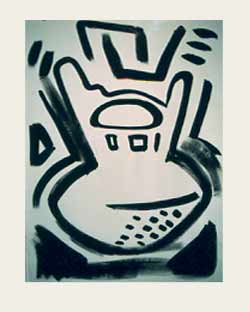Grafitti Redux
While reading the daily postings of MUSEUM-L, a discussion group for museum professionals, I was surprised to come upon a passionate argument about, of all things, graffiti. Somehow the subject had come up and it instantly reanimated a debate that I thought belonged to a brief interlude in the early 80's. Was graffiti artistic expression or common vandalism? Were public transgressions such as graffiti akin to the civil disobedience of a Thomas Paine or a Martin Luther King, Jr. or simply crude and unsightly indicators of modern society's gradual disintegration? I was a bit surprised that most of the MUSEUM-Lers were properly horrified by graffiti. (Surprised because I figured people working in museums couldn't be that focused on financial success in a free market economy and thus might be a bit more open to the rude noise of any remaining countercultural forces.) The common argument revolved around its illegal incursions on public and private property. Like New York's mayor Rudy Guiliani and other neo-con leaders, some participants felt the eradication of graffiti, although seemingly a trivial accomplishment, would add greatly to the "quality of life" environment of our cities, thus making them a friendlier place for economic revitalization. And many of the anti-graffitites had strong sympathies with those whose property had been violated without their consent.
These are unquestionably valid points, but I must admit my fellow feeling swayed toward the few pro-graffiti dreamers rather than the majority of anti-graffiti pragmatists. One reason for this is that I remembered, as we all do in the art world, the brief glamorous heyday of graffiti art. The work of New York street artists like CRASH, DAZE, Lady Pink, and Futura 2000 first appeared in gritty alternative spaces, most notably Fashion Moda in the Bronx, as either documentation or in-gallery installations. Then it made its way into the commercial scene and even a few museums. Now, many of these artists are spray-painting on canvas, although their popularity seems restricted to European venues where the art scene is much more tolerant of trends Americans have long classified as defunct. Many historians of the period maintain that graffiti art was doomed as soon as it entered the galleries at all; it was only convincing as an illegal, albeit vibrant form of public art. While this is another compelling point, two things still interest me about graffiti: 1, the act (rather than the object, art or not) and 2, graffiti's contemporary incarnation on the frontiers of cyberspace.

Interestingly, documentation, bibliographies, and histories of graffiti
abound on the Internet. The aforementioned Futura 2,000 maintains several
sites where, although his continuing gallery career is mentioned, he seems
far more interested in using the net to express his spin on contemporary
culture. The net is a vast, ever-expanding wall for anyone who wants to
make their mark; we click around through a jungle of hypertext tags with
the same anti-linearity abandon currently being eradicated from the walls
and subways of Manhattan. Sites documenting and celebrating graffiti,
cyber-"walls" where you can add uncensored comments and read those of
others, even sites where you can report graffiti to the police or learn
about good solvents to remove it all exist cheek by jowl in a state of
semi-anarchy. Most personal homepages are little more than legal graffiti,
vigorous attempts to assert individual identity in the homogenous world
of commercial mass media.
Meanwhile, real graffiti--the physical kind--refuses to disappear. Much of what I see is in the traditional venues: bathrooms, public walls, and billboards. In some ways, the opportunities are increasing because now, in addition to barroom sanctuaries for street poetry, coffee shops offer similar outlets (North Buffalo's Stimulance is a particularly rich, if often jejune source). While traveling through Western New York, I'm always impressed by the adventurous feats of the billboard artists. Now, many would call putting a mustache and goatee on the huge face of some lawyer looking for bankrupts, divorcees, accident victims, and other unfortunates amateurish vandalism, not art, but I would have to agree with Mark Dery's definition of such acts as "culture jamming." In a 1994 pamphlet of the same name, published by Open Magazine, Dery writes, "Part artistic terrorists, part vernacular critics, culture jammers, like Eco's "communications guerrillas," introduce noise into the signal as it passes from transmitter to receiver, encouraging idiosyncratic, unintended interpretations. Intruding on the intruders, they invest ads, newscasts, and other media artifacts with subversive meanings; simultaneously, they decrypt them, rendering their seductions impotent."
In other words, the silly mustaches that somebody risked their lives and liberty to add to a billboard alter the impact of the advertisement, prompting us to continue the image's deconstruction as we look at it. It's similar to the way artists like Barbara Kruger and Cindy Sherman question mass media's production of cultural stereotypes and hidden sociopolitical messages. A different, more forthright method of graffiti is being practiced by civic and religious leaders in inner city neighborhoods, who regularly paint over advertisements for cigarettes and liquor, existing in unusual and questionable proliferation in such communities.
Many cities have tried to defuse the irrepressible impulse of graffiti by providing legal outlets in public spaces where you can write with impunity. Although this misses Dery's point of constructive transgression, it's not a bad idea. It reinforces our sense that the city environment belongs to the people that live in it as much as to a suburban-dwelling developers' whimsy. Even legal murals, which may be experiencing some resurgence in Buffalo, share graffiti's strongest justification: the importance of asserting a human presence in the often-monotonous canyons of urban architecture.
Artvoice, 1996

